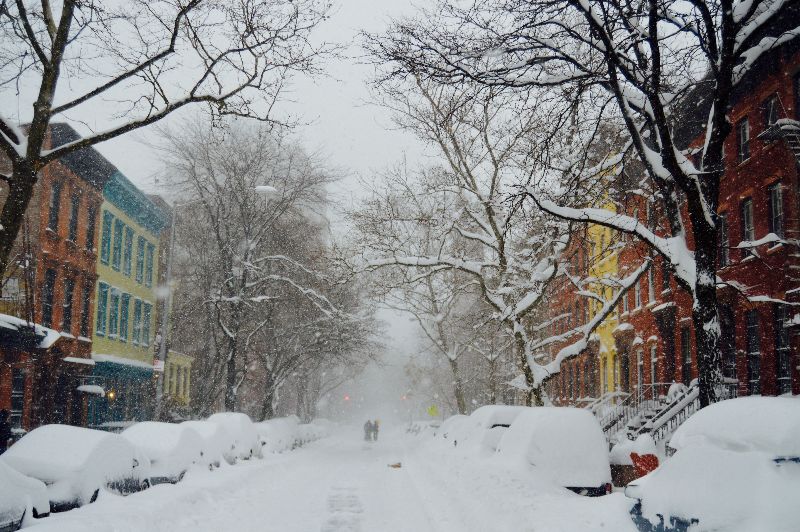Prepping Rentals for Winter Weather Year-Round
| . Posted in News - 0 Comments
By Eric Weld, MassLandlords, Inc.
Preparing rentals for the ravages of winter weather is a yearlong campaign in Massachusetts. Almost every property owner has to deal with summer’s humidity and pests, followed by fall’s piles of leaves and oncoming cold. But among all the year’s weather threats to homes and rentals, the worst, and potentially most devastating, come in winter and early spring.

Prepping rentals for the harsh weather of winter and early spring is a year-round endeavor in Massachusetts. Image CC BY-SA PxHere
Ice, drifting snow, pounding winds and penetrating rain can all threaten your properties. Worse, these conditions can also create dangerous conditions for your renters.
By the time winter rolls around each year, you’ve likely addressed some cold weather-proofing measures at your rentals. But there might remain a few steps you can take to further secure your properties against catastrophe from snow, ice and freezing temps.
And every year, spring will follow with its heavy, accumulating rainfalls, which can mean disaster for an un-weatherized structure.
To assist with your annual weather preparedness, we created a checklist below of home weather-proofing steps that you and your tenants can take throughout the year to protect properties from water, wind, snow and ice.
Save money on winter prep by stocking up in summer
“Always buy your straw hats in the winter,” advised legendary investor Benjamin Graham, author of the timeless tome The Intelligent Investor.
Straw hats may be passé fashion, but the advice is still sound: The ideal time to buy winter supplies is in the summer, just as you might buy beachwear in the winter. Prices are lower when demand is lower. Once fall arrives and winter approaches, shoppers start clearing the store shelves of snow boots, shovels, space heaters, ice melt and sand.
For best savings, purchase calcium chloride – one of the most common de-icing materials – in bulk in August, when prices are cheapest, then store it until needed. The same principle applies to rock salt, also known as sodium chloride. Which one is better?
Also, it’s smart to book service and inspection appointments with heating system technicians in the summer, when their schedules are leaner. In some cases, they might even offer a better rate in the off season when they don’t have to squeeze you in.
Now for that checklist:
Home weather prep Step 1: Roof drains and gutters
Central, flat roof drains, like those on thousands of multi-unit rentals in Massachusetts, can cause massive harm if not cleaned, cleared (i.e., snaked) and maintained, at least bi-annually. A Springfield landlord learned that the hard way in a spring 2018 roof collapse. Fortunately, no one was hurt in the incident.
Flat roofs should be monitored throughout the year, especially around snow, ice and heavy rainfalls, to make sure they are draining properly. Even if flat roof drains are clean and clear, other factors can still cause problems. A buildup of ice around the drain, for example, can keep melt from entering the drain. Also, flat roof drains typically empty into city sewers rather than storm drains. As a result, during heavy rainfalls – which, thanks to climate change, are increasingly becoming a winter concern in addition to spring – flat roof drains become susceptible to backups due to overtaxed sewers.
But who has the time to ascend their roofs and monitor drains every time it storms?
Charles Hadsell, CEO and cofounder of ePropertyCare, a company that integrates smart-building technology solutions for rentals, suggests a couple of options for remote roof drain monitoring. Most practically, Hadsell suggests an electronic thermostat that can be installed inside roof drains in order to warn owners or others of potential problems before disaster happens. His company also offers an electronic system that can detect burst pipes, running toilets and leaks.
Gutter cleaning and gutter guards
Gutters and downspouts might be relatively easier to manage, especially with the proliferation of gutter guard products in recent years. Keeping gutters and downspouts clean and clear is a must, to allow the free flow of water (i.e., rain, snow and ice melt) down to the ground level and away from home and building foundations. And importantly, cleared gutters carry water off the roof, an essential step in avoiding the buildup of ice and snow that can result in dreaded ice dams.
Gutter guards, also known as gutter helmets, have become a popular product for keeping debris like leaves and roof runoff from mucking up and clogging gutters. These are linear protective covers affixed over the top of gutters. Gutter guards are either meshed or vented to allow rain water and roof melt to enter the gutter while blocking debris. There are dozens of brands and installation companies to choose from, and prices range from an estimated $7.50 to $12.50 per linear foot installed. Commercial size gutter guards are also available for large buildings, and will permit more leaf and debris through-movement when debris does enter the system.
But note: gutter guards, while they will cut down on gutter cleaning, won’t necessarily free you from ever cleaning your gutters again. Small debris from trees (think pine needles and seeds) can still enter your gutters and build up over time, and must be cleaned out (lest seeds sprout and grow into small trees) – but not nearly as frequently with gutter guards installed.
Home weather prep Step 2: Trimming trees, structure integrity
While you are outside contending with gutters, check all the trees on your properties. Lop and trim any branches hanging over roofs, as well as any dead branches and limbs that seem vulnerable to breaking off and falling in high winds or when weighed down with snow and ice. This is a smart safety step recommended by FEMA, but it could also spare you expensive repairs such as damaged window or siding replacements.
At no point should any plants – tree branches, shrubs, bushes, etc. – be touching the siding, roof or foundation of the building. Ideally, there should be at least a six-inch gap between any branches or bushes and the structure to avoid transfer of moisture onto or into the house.
Next, check all around the exterior of your properties to make sure roofing tiles, siding, masonry and shutters are in place and secure. Winter storms work against the structural integrity of your homes and buildings by tearing at loose corners with extreme winds and freezing rain. Moisture can find its way under roof tiles and siding, and then expand as ice, pushing up pieces and loosening them to be torn away by the next storm’s winds.
While checking the exterior, keep an eye out for tiny holes, cracks or potential air leaks around window and doorframes in particular, and repair them with caulking and other materials.
Finally, outside, all hoses and any garden tools or exterior furniture should be stored inside for winter, and outside spigots and pipes drained and insulated. If you don’t have a spigot drain, shut off the water and leave the spigot open: Water that starts to freeze will have a pressure outlet, reducing the chance of a burst pipe.
Home weather prep Step 3: On the inside
As important as exterior weather preparedness is to the long-term integrity of rental properties, it’s equally important to take steps inside. Schedule rental unit entrances with tenants as needed.
An annual inspection by a heating system technician is recommended (see above regarding summer scheduling). At minimum, have a licensed HVAC technician or plumber replace the furnace filter once a year. Boilers may benefit from preventative thermocouple replacement. Thermocouples can wear out and fail over time, and are easy to replace.
As part of heating system inspections, be sure to include the chimney. Ideally it should be cleaned once a year, but also checked to make sure there are no cracks in the mortar or between bricks, no bricks are pushed out, and no leakage is present around the base. In the long term, plan to install a chimney liner, especially if you’ve upgraded to a high-efficiency furnace, which can introduce damaging moisture inside the chimney.
While in the basement, look around for any signs of animals, such as mice, infiltrating. In some houses, especially older structures, it might seem next to impossible to keep out mice. They can squeeze their bodies through gaps, cracks and holes the size of a dime. Check for holes around the foundation and fill in any gaps with steel or copper wool and PUR Black foam. Look closely at entry points, such as water pipes coming from outside, to make certain they are sealed all around.
Home weather prep Step 4: Working with tenants
A crucial step in rental weather preparation is communicating with tenants. Some weather preparedness is, after all, renters’ responsibility, and you and they should be clear about which areas they will pay attention to.
For example, make sure your renters know where the water shutoff valve is located inside. In the unfortunate event of a burst pipe, a tenant who knows exactly where to turn off the water could save valuable minutes of flooding.
You might make an annual appointment to go over potential emergency scenarios with your tenants to make sure you’re all on the same page regarding steps to take in case of severe weather and/or service outages. Consider sharing a list of emergency contacts of people to contact directly (to save time) in case of furnace malfunction, pipe burst or other disaster.
Home weather prep Step 5: Springtime
When spring arrives, a little bit of weather preparedness can bring a lot of benefit. Spring’s warmer temperatures are always welcome in Massachusetts, but they turn winter’s ice and snow into a home’s worst enemy.
Keeping ice and snow melt and rain away from your property as much as possible can avoid a host of troubles, from basement flooding and mold to moss and algae growth on roofs and siding, along with dreaded wood rot. In extreme cases, such as problems with interior mold, lawsuits can follow.
A few simple steps can avoid most home water damage.
Downspout extenders
Affix plastic extenders to all downspouts (unless you have a French drain system). This is a simple solution with significant benefit. Moving winter melt and rainwater out away from the foundation through simple, inexpensive downspout extenders can make the difference between a dry basement and a constantly flooding and/or moldy one.
Waterproof foundation
Ideally, the foundations of your properties were properly waterproofed when built. But if your rental buildings are more than 40 years old, chances are the foundations weren’t waterproofed. You could consider having them waterproofed now, but it can be an expensive job, and the price and procedure will depend on whether you have a concrete or stone foundation.
For concrete foundations, the above-ground portion of the exterior should be treated with a damp-proofing mixture (usually tar- or asphalt-based). Such treatment has a shelf life and should be checked annually for any cracks or potential leaky areas.
Stone-foundation waterproofing is a more debatable proposition, and notoriously difficult to achieve. Keeping water from entering (and freezing in) the countless nooks and crevices in the stone wall is the key. Repointing the foundation may help with moisture seepage, but absolute waterproofing from the exterior includes an expensive excavation and drain installation. Some argue that stone foundation waterproofing is most cost effective from the interior, with an application of polyurethane foam to the walls and some kind of plastic barrier affixed around the base perimeter and floor, if possible. A sump pump might be necessary for buildings with stone foundations.
When examining foundations, check the soil against the foundation walls. There should be no mini-ditches or recessed areas in the dirt. All soil should be pitched up toward the house, sloping down from the structure for natural drainage away.
Thoughts of Summer
Keeping a house or building structurally sound and its occupants safe and comfortable is an ongoing, year-round process.
Wind, rain, snow and ice and extreme temperatures wreak havoc on our homes and rentals and can threaten the well-being of tenants, and therefore create vulnerability to litigation for landlords.
By taking steps year-round, and keeping yourself and your tenants informed, you give yourself the best chance of making it through the fraught winter and spring months with healthy properties and happy tenants.




